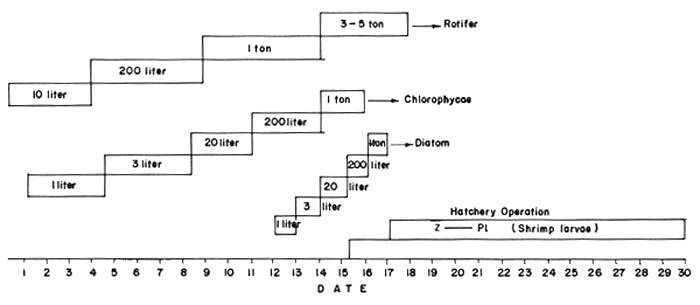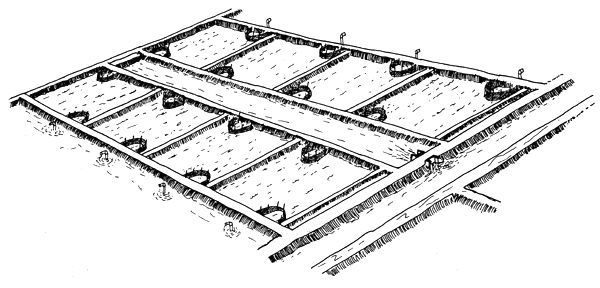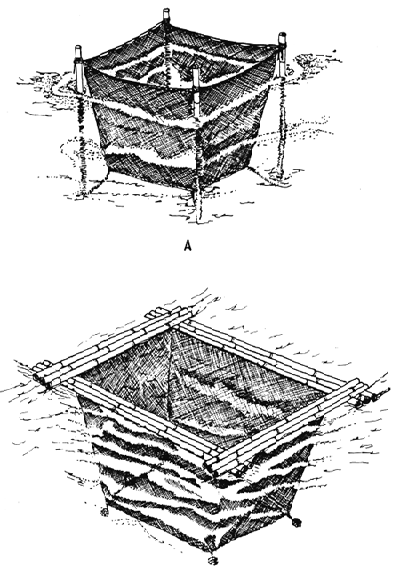Since small tank nurseries normally produce up to P5 - P6 postlarvae only, such stages cannot be stocked directly in grow-out ponds. Therefore, nursing of postlarvae from the small hatchery is still necessary. Nursing of postlarvae can be done in many ways, viz: in concrete tank, earthen pond or in net cages.
Concrete tanks are prepared by filling up with filtered seawater provided with aeration and pure cultures of diatom added to preserve water in good condition and make it less transparent. Ideal stocking density of the larvae is about 50/cubic meter of water. It is advisable to use substrates to increase surface area in the nursery tank, because postlarvae have a habit of clinging to the wall and tank bottom. Polyethylene nettings can be used and being synthetic, they do not decompose in water and can last longer without deterioration.

Fig. 32 A. PROGRAMMING OF NATURAL FOOD CULTURE FOR HATCHERY

| N = Nauplius | Fertilizer | KNO3 | 3 g/m3 | |
| Z = Protozoea | NA2HPO4 | 0.3 g/m3 | ||
| M = Mysis | Diatom/Phytoplanktom | Skeletonema | costatum | 40,000–50,000 cells/ml |
| P = Post larvae | Tetraselmis | sp. | 10,000 cells/ml | |
| Chaetoceros | sp. | 40,000–80,000 cells/ml | ||
| Supplementary feed | Fertilized eggs of oysters | |||
| Soybean cake | ||||
| Soybean curd | ||||
| Egg custard | 10μg/larva/day | |||
| Egg yolk | ||||
| Dry acetes | 10μg/larva/day | |||
| Fresh acetes | 50μg/larva/day | |||
NOTE: Supplementary feed should be used together with either phytoplankton or fertilizer. Cannot be used independently.
Fig. 32B. Feed and feeding scheme for shrimp larvae.
The early stages of larvae are fed with Artemia, while the older ones are given chopped mussel or cockle meat. Young and adult Artemia may also be added to the diet throughout the nursery period which takes about a month. Water is changed daily at 50% of the total capacity. Flow-through system is permitted in the nursery tank as this results in good growth and survival rates.
Nursery pond size ranges from 500 to 20002 and water depth at 40–70 cm. The nursery pond should have at least one gate installed with a fine screen (1 mm mesh size) to prevent predators and competitors from entering (Fig. 33).
P9-P10 are suitable sizes for stocking in the nursery ponds. Stocking density is 100–150 individuals per square meter.
Prior to stocking, the pond should be completely drained and dried until soil cracks. In cases where the pond cannot be completely drained, derris root (Rotinone) may be applied at 20 kg/ha to eradicate predators. Derris root is crushed until it breaks, soaked on water overnight and the resulting milky solution applied. Fertilizers are applied at 1000 kg/ha and 50 kg/ha for organic (chicken manure) and inorganic (Ammonium sulphate) fertilizers, respectively.
Water exchange depends upon the time of spring tide when water can enter the pond. Chopped mussel or cockle meat are fed to the larvae at the rate of 10% the total biomass. The culture period lasts 30–45 days when larvae becomes P40 or P60.
Cages made of synthetic netting can either be floating or stationary in calm water in bays, lagoons or fishponds. Sites for installation of the nursery cages should be as far as possible free from biofouling because nursery cages are made of very small mesh size nettings which can be easily covered up by bio-foulers and thus prevents water exchange. The cages are normally supported by frame and by floating bouys made of bamboo or styrofoam drums. Stationary cages are held up by bamboo or wooden poles (Fig. 34).
Postlarvae (P6–7) is suitable for stocking in cages at a stocking density of 1000–2000 per cubic meters of water. Feeding scheme is similar to that in earthen pond nursery.

Fig.33. NURSERY POND

Fig. 34 Nursery Cages